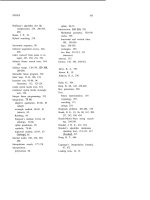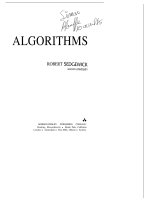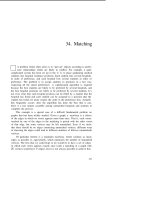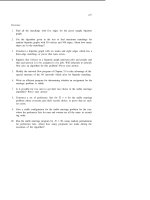Tài liệu Thuật toán Algorithms (Phần 5) ppt
Bạn đang xem bản rút gọn của tài liệu. Xem và tải ngay bản đầy đủ của tài liệu tại đây (86.33 KB, 10 trang )
3. Random Numbers
Our next set of algorithms will methods for using a computer to
generate random numbers. We will find many uses for random numbers
later on; let’s begin by trying to get a better idea of exactly what they are.
Often, in conversation, people use the term random when they really
mean arbitrary. When one asks for an number, one is saying that
one doesn’t really care what number one gets: almost any number will do.
By contrast, a random number is a precisely defined mathematical concept:
every number should be equally likely to occur. A random number will satisfy
someone who needs an arbitrary number, but not the other way around.
For “every number to be equally likely to occur” to make sense, we must
restrict the numbers to be used to some finite domain. You can’t have a
random integer, only a random integer in some range; you can’t have a random
real number, only a random fraction in some range to some fixed precision.
It is almost always the case that not just one random number, but a
sequence of random numbers is needed (otherwise an arbitrary number might
do). Here’s where the mathematics comes in: it’s possible to prove many facts
about properties of sequences of random numbers. For example, we can expect
to see each value about the same number of times in a very long sequence
of random numbers from a small domain. Random sequences model many
natural situations, and a great deal is known about their properties. To be
consistent with current usage, we’ll refer to numbers from random sequences
as random numbers.
There’s no way to produce true random numbers on a computer (or any
deterministic device). Once the program is written, the numbers that it will
produce can be deduced, so how could they be random? The best we can hope
to do is to write programs which produce of numbers having many of
the same properties as random numbers. Such numbers are commonly called
pseudo-random numbers: they’re not really random, but they can be useful
33
CHAF’TER 3
as approximations to random numbers, in much the same way that
point numbers are useful as approximations to real numbers. (Sometimes it’s
convenient to make a further distinction: in some situations, a few properties
of random numbers are of crucial interest while others are irrelevant. In
such situations, one can generate quasi-random numbers, which are sure to
have the properties of interest but are unlikely to have other properties of
random numbers. For some applications, quasi-random numbers are provably
preferable to pseudo-random numbers.)
It’s easy to see that approximating the property “each number is equally
likely to occur” in a long sequence is not enough. For example, each number in
the range appears once in the sequence . . but that sequence
is unlikely to be useful as an approximation to a random sequence. In fact,
in a random sequence of length 100 of numbers in the range it is
likely that a few numbers will appear more than once and a few will not
appear at all. If this doesn’t happen in a sequence of pseudo-random numbers,
then there is something wrong with the random number generator. Many
sophisticated tests based on specific observations like this have been devised
for random number generators, testing whether a long sequence of pseudo
random numbers has some property that random numbers would. The random
number generators that we will study do very well in such tests.
We have been (and will be) talking exclusively about uniform random
numbers, with each value equally likely. It is also common to deal with random
numbers which obey some other distribution in which some values are more
likely than others. Pseudo-random numbers with non-uniform distributions
are usually obtained by performing some operations on uniformly distributed
ones. Most of the applications that we will be studying use uniform random
numbers.
Applications
Later in the book we will meet many applications in which random numbers
will be useful. A few of them are outlined here. One obvious application is in
cryptography, where the major goal is to encode a message so that it can’t be
read by anyone but the intended recipient. As we will see in Chapter 23, one
way to do this is to make the message look random using a pseudo-random
sequence to encode the message, in such a way that the recipient can use the
same pseudorandom sequence to decode it.
Another area in which random numbers have been widely used is in
simulation. A typical simulation involves a large program which models some
aspect of the real world: random numbers are natural for the input to such
programs. Even if true random numbers are not needed, simulations typically
need many arbitrary numbers for input, and these are conveniently provided
by a random number generator.
RANDOM NUMBERS
35
When a very large amount of data is to be analyzed, it is sometimes
sufficient to process only a very small amount of the data, chosen according
to random sampling. Such applications are widespread, the most prominent
being national political opinion polls.
Often it is necessary to make a choice when all factors under consideration
seem to be equal. The national draft lottery of the or the mechanisms
used on college campuses to decide which students get the choice dormitory
rooms are examples of using random numbers for decision making. In this
way, the responsibility for the decision is given to “fate” (or the computer).
Readers of this book will find themselves using random numbers exten-
sively for simulation: to provide random or arbitrary inputs to programs.
Also, we will see examples of algorithms which gain efficiency by using random
numbers to do sampling or to aid in decision making.
Linear Congruential Method
The most well-known method for generating random numbers, which has been
used almost exclusively since it was introduced by D. Lehmer in 1951, is the
so-called linear congruential method. If a contains some arbitrary number,
then the following statement fills up an array with random numbers using
this method:
for to N do
$1) mod m
That is, to get a new random number, take the previous one, multiply
it by a constant b, add 1 and take the remainder when divided by a second
constant m. The result is always an integer between and m-l. This is
attractive for use on computers because the mod function is usually trivial to
implement: if we ignore overflow on the arithmetic operations, then most com-
puter hardware will throw away the bits that overflowed and thus effectively
perform a mod operation with m equal to one more than the largest integer
that can be represented in the computer word.
Simple as it may seem, the linear congruential random number generator
has been the subject of volumes of detailed and difficult mathematical analysis.
This work gives us some guidance in choosing the constants b and m. Some
“common-sense” principles apply, but in this case common sense isn’t enough
to ensure good random numbers. First, m should be large: it can be the
computer word size, as mentioned above, but it needn’t be quite that large
if that’s inconvenient (see the implementation below). It will normally be
convenient to make m a power of 10 or 2. Second, b shouldn’t be too large or
too small: a safe choice is to use a number with one digit less than m. Third,
CHAPTER 3
b should be an arbitrary constant with no particular pattern in its digits,
except that it should end with with even: this last requirement is
admittedly peculiar, but it prevents the occurrence of some bad cases that
have been uncovered by the mathematical analysis.
The rules described above were developed by whose textbook
covers the subject in some detail. Knuth shows that these choices will make
the linear congruential method produce good random numbers which pass
several sophisticated statistical tests. The most serious potential problem,
which can become quickly apparent, is that the generator could get caught
in a cycle and produce numbers it has already produced much sooner than
it should. For example, the choice with a[ I] produces the
sequence
a sequence of integers between 0
and 380.
Any initial value can be used to get the random number generator started
with no particular effect except of course that different initial values will give
rise to different random sequences. Often, it is not necessary to store the
whole sequence as in the program above. Rather, we simply maintain a global
variable a, initialized with some value, then updated by the computation
mod m.
In Pascal (and many other programming languages) we’re still one step
away from a working implementation because we’re not allowed to ignore
overflow: it’s defined to be an error condition that can lead to unpredictable
results. Suppose that we have a computer with a 32-bit word, and we choose
m 415821, and, initially, All of these values are
comfortably less than the largest integer that can be represented, but the first
a* operation causes overflow. The part of the product that causes the
overflow is not relevant to our computation, we’re only interested in the last
eight digits. The trick is to avoid overflow by breaking the multiplication up
into pieces. To multiply p by q, we write p = + and = +
so the product is
+ +
= + +
Now, we’re only interested in eight digits for the result, so we can ignore
the first term and the first four digits of the second term. This leads to the
following program:
37
program random output)
a, integer;
function q: integer): integer;
var pl, integer;
begin
div ml mod ml ;
:=q div ml; mod ml;
mod mod m;
end
function random : integer
begin
mod m;
random :=a;
end
begin
a);
for to do
end.
The function in this program computes mod m, with no overflow
as long as m is less than half the largest integer that can be represented. The
technique obviously can be applied with for other values of ml.
Here are the ten numbers produced by this program with the input =
10 and a = 1234567:
358845’08
80001069
63512650
43635651
1034472
87181513
6917174
209855
67115956
59939877
There is some obvious non-randomness in these numbers: for example,
the last digits cycle through the digits O-9. It is easy to prove from the
formula that this will happen. Generally speaking, the digits on the right are









